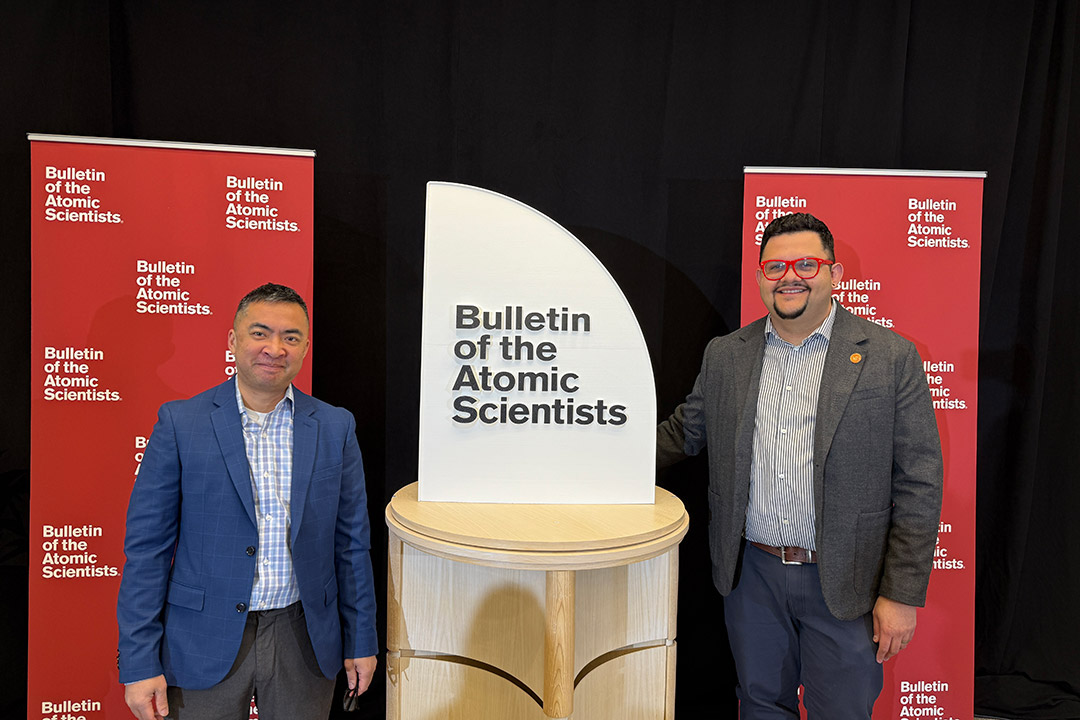Faculty member helps redesign ‘Doomsday Clock’
An RIT faculty member helped redesign an infamous clock that made international headlines this week—and the body of the clock was printed in RIT’s SHED.
Juan Noguera, assistant professor in RIT’s School of Design, and Tom Weis, associate department head at the Rhode Island School of Design (RISD) and founder of Altimeter Design Group, redesigned the “Doomsday Clock,” a symbolic attempt to assess how close humanity is to destroying the world.

Provided
From left, Tom Weis and Juan Noguera pose next to the back of the redesigned “Doomsday Clock,” which was unveiled on Jan. 28 in Washington, D.C.
Created 78 years ago, the time is set by the Bulletin of the Atomic Scientists’ Science and Security Board. On Jan. 28, the redesigned clock was unveiled and set to 89 seconds to midnight during an annual event at the United States Institute of Peace. This moves the clock one second forward, the closest the clock has ever been to midnight, according to AP News.
Representatives from the Bulletin of the Atomic Scientists contacted Altimeter Design Group about the redesign of the clock in 2024. The firm has collaborated with several esteemed national and international organizations, including the United Nations, Sandia National Laboratories, and the Naval Postgraduate School.
The designers first met when Noguera was a student at RISD and Weis was his professor. This redesign offered an opportunity for them to collaborate and use design to underscore an important message for the world.
Noguera and Weis agreed to combine both traditional and modern techniques in the redesign. The clock’s base was crafted with traditional woodworking techniques, the body and components of the clock’s face were 3D-printed in the SHED, and the pair used a combination of pencil-sketching and artificial intelligence (AI) visualization tools in the ideation process.
The resulting design was more akin to a sculpture than the previous clocks—with the addition of the hand-crafted wooden base and a larger body—and commanded a presence when presented to global audiences.
“We liked the juxtaposition of the traditional wood crafting techniques and the 3D-printed and AI elements. We think it represents what the Bulletin is trying to communicate,” said Noguera. “We know that the world is changing, but we can’t forget about what happened in the past because we need to learn from it.”
Noguera has consistently advocated for the use of AI to transform the creative process and has used it to inform his own work. One example is a 2023 artwork created in collaboration with Paolo Cardini called “PastFastForward,” which aimed to give autonomy to Guatemalan traditional artisans.
While the symbol of the “Doomsday Clock” is far from positive, Noguera shared that he and Weis leaned into optimism when working on the project. The pair designed the new clock to be modular, attaching the text and hands on the clockface with magnets and providing additional letters and numbers.
“I think everyone hopes that the clock changes and that, instead of being seconds from midnight, we can move back to minutes,” said Noguera. “Hopefully, they can make use of those other numbers and letters that are now in their toolset in the future.”
The clock is set to be displayed at the Bulletin of Atomic Scientists’ office in Washington, D.C.
“Reimagining such a powerful symbol, one that has resonated for decades as a measure of existential risk, was both a privilege and a challenge,” said Weis in a collaborative artist’s statement. “This redesign goes beyond mere aesthetic enhancements; it reaffirms our responsibility as designers to engage with both the past and the future, to wield technology judiciously, and to create things that not only serve as objects of design, but also convey narratives of adaptability, resilience, and hope.”
Go to the Bulletin’s YouTube to watch the full press conference.











